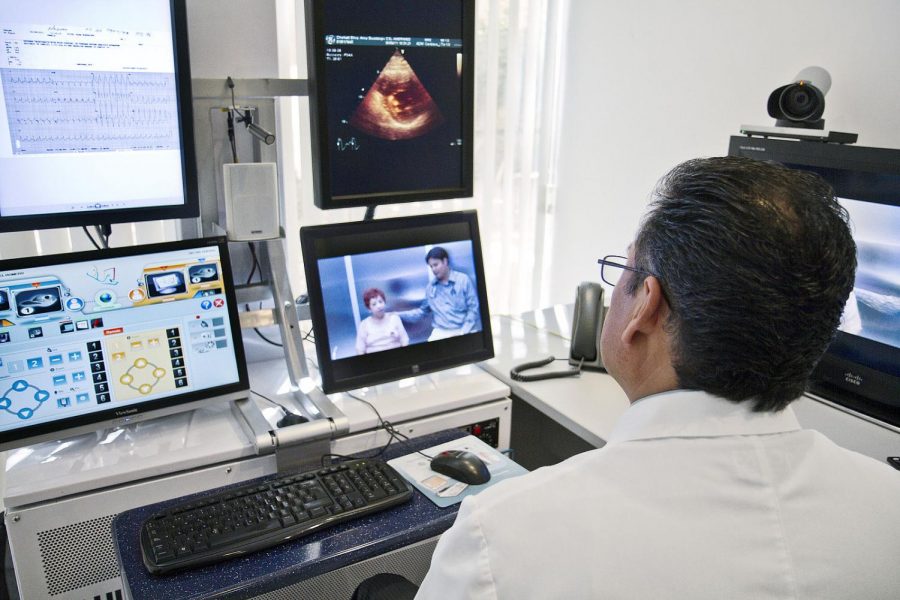My Doctor Is Frozen… On Zoom
A cardiologist at a hospital in Mexico is in a pre-surgery consultation with a patient and her doctor, who are in California. Patient information such as charts and scans can be exchanged in seconds, and physicians who are geographically isolated can now hear and see each other well during consultations.
As the COVID-19 pandemic continues to worsen and impact daily life, people around the globe have had to accommodate a lifestyle of mask-wearing and social distancing. As healthcare professionals seek to balance the treatment of their patients with the safety concerns for themselves as well as their employees and the patients, the demand for telemedicine has drastically increased. Telemedicine, as defined by the Oxford Dictionary, is “the remote diagnosis and treatment of patients by means of telecommunications technology.” Through this time of remote learning and work, it does not come as a big surprise that medicine has also become highly dependent on the advancements of technology.
The use of telemedicine has increased recently, especially as access to the internet has increased. Telehealth covers a wide variety of facilities, such as remote clinical care and health management, utilizing digital information and telecommunications innovations. However, the implementation of telehealth services has varied across jurisdictions. In January, just twenty-four percent of healthcare providers in the United States had a virtual healthcare system in operation. Additionally, before the outbreak of COVID-19, telemedicine was restricted by a range of state and federal licensing and compensation guidelines for providers across national lines. It was also restricted because of the Health Insurance Portability and Accountability Act, or HIPPA laws. According to the U.S Department of Health and Human Services, HIPPA was primarily developed to modernize the exchange of health information, to provide for the protection of personally identifiable information held by the healthcare and health insurance industries against fraud and theft, and to resolve limits on health insurance coverage.
Although the search for a vaccine recently came to an end, the burden on medical professionals and hospitals has led to an unprecedented shift towards the authorization and implementation of telehealth services. Entangled in years worth of disputes about its efficacy in delivering patient care, telehealth has also faced other barriers to its acceptance and use, including licensing, reimbursement, and valid services. Nevertheless, in response to the outbreak of coronavirus, the Trump administration and the U.S. Department of Health and Human Services (HHS) fully authorized the use of telehealth services as part of the Coronavirus Preparedness and Response Supplemental Appropriations Act. [7], according to the Brookings Institution. As part of this newly granted authorization, most of the Medicare payment conditions were waived and patients were able to access remote care, no matter where they lived. Telehealth services were also paid at the same rate as in-person or comparable medical services during the pandemic. The drive to accelerate the usage of telehealth services also included other exemptions, including certain HIPAA exceptions for providers where Facetime or Skype is used by physicians to connect with patients.
Telehealth network advocates have argued that these guidelines have stopped virtual treatment from achieving its full potential. Telemedicine may help patients resolve factors that contribute to health inequalities such as transportation, costs, and access to quality care, especially for abortion and mental health services. Those living far from medical services and socioeconomically disadvantaged communities are frequently unable to receive follow-up or emergency care. Any of these challenges may be alleviated by telemedicine.
However, critics have highlighted the medical, ethical, and legal drawbacks of increasing acceptance of telemedicine and have raised questions about access to the internet and technology in rural areas, confidentiality, and fraud. Critics have also argued that in certain cases, telemedicine does not replace face-to-face visits, and that virtualization will not be a realistic option unless more measures to subsidize and expand access to treatment were taken by the government. Some healthcare workers have stated that the effectiveness of telehealth eventually depends on better instruments and technology for communication.
According to a survey, more than four times as many doctors are using telemedicine to care for patients now than before the pandemic. Around 66 percent of 1,594 U.S. doctors across all 50 states and different specialties have practiced telemedicine, up from 16 percent who reported using the technology before the pandemic, said the National Lifeline Association, using data from the virtual network operator TruConnect. “The telemedicine industry has made leaps and bounds during this time, mostly due to awareness to the U.S. population and also due to doctors needing to find a way to continue to care for their patients when those patients don’t want to go into a medical office,” said Wayne Orchard, executive vice president of MyTelemedicine. Doctor on Demand, another telemedicine firm, said that since the pandemic began, it has experienced a great increase in new patient registrations and medical visits. Therapy visits have more than tripled since last year, and since February, as reports of of poor mental have gone up 360% since the pandemic began, according to Women’s Health Magazine.
Analysts predict that the COVID-19 pandemic will radically change the way patients seek and receive health care because measures of social distancing have driven people to avoid the offices, hospitals, and clinics of physicians. Is telemedicine here to stay, in light of the coronavirus outbreak? And maybe even after?






